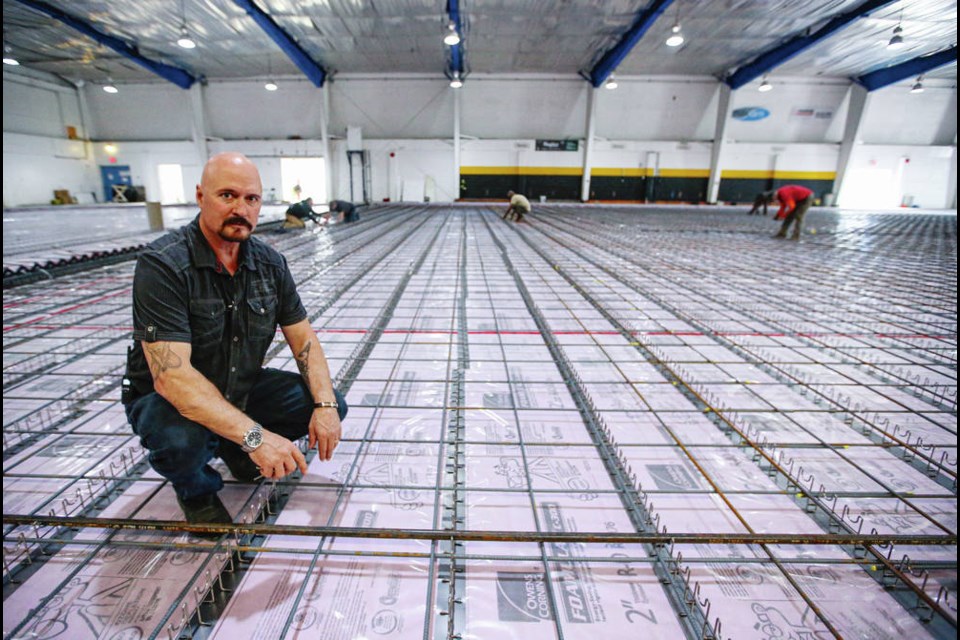The next time you swim or skate or use the child-care services at Juan de Fuca Rec Centre, be assured that it’s well on its way to becoming one of the most energy-efficient facilities of its kind in Canada.
A massive overhaul of mechanical systems that cool the ice and heat the pool — not to mention all of the public spaces — is nearing completion.
Most of what’s new is hidden from view in the basements and rooftops, but there will be noticeable changes in cleaner air and more efficient systems and a steep decline in operating costs.
The new energy-recovery systems are expected to shave nearly $20,000 off the annual electric bill at Juan de Fuca pool and about $24,000 from the rink’s annual total, said Wade Davies, operations manager at West Shore Parks and Recreation.
“That’s a huge savings to taxpayers,” said Davies.
Davies also points to the environmental advantage, noting the new operating systems for the pool and rink are expected to reduce greenhouse gas emissions by 62%, or 284 tonnes per year. That’s the equivalent to planting 14,220 trees, taking 61 cars off the road or heating 54 houses each year.
West Shore partnered with Victoria-based company Polar Engineering to secure the grants and design the new systems. A federal infrastructure grant covered most of the $2.09-million project, with taxpayers picking up $700,000 and the province kicking in $90,000 through a Clean B.C. grant.
The swimming pool’s energy-recovery system captures heat from the warm air previously exhausted to the atmosphere, and uses it to heat the facility’s pools and change rooms.
To do this, Polar Engineering chief engineer Ian Welle said an energy recovery dehumidifier was installed on the roof of the facility to extract heat from the air leaving the pool. The recaptured heat is pumped down to the mechanical room, where it is transferred to the pool water and space heaters through a series of heat exchangers.
Welle said the recaptured heat significantly reduces the natural gas consumption of the building’s boilers and air handling units.
The arena’s new system will take waste heat from the refrigeration plant and use it to provide space and water heating throughout the building.
“Unbeknownst to most people, you do not cool an arena, you pull heat out of the arena,” said Davies.
He said with the old arena refrigeration system, the heat is removed from the ice floor through cooled brine lines and exhausted to the atmosphere through a condensing unit at the back of the arena. To stop frost heaving under the frozen floor, there were heated cables (37,800 watts) under the insulated floor that ran continuously.
Davies said the new refrigeration system removes the heat from the cooled arena floor and transfers that free heat to the new brine lines that circulate under the insulated cold floor and to the air handling units servicing all the other rooms in the Juan de Fuca building.
The existing arena floor and all bleacher benches and arena boards are being torn out and recycled. New heating lines and insulation are being installed, and a new floor will be poured around the new cooling lines.
There will be new boards and glass as well as new individual stadium seating.
“Whenever West Shore Parks is considering any new upgrades to the facilities, we are always looking at innovative ways to reduce our energy usage and lower our carbon footprint,” said Davies.
Welle, who founded Polar Engineering, specializes in the design of industrial refrigeration and energy-recovery systems.
He designed a similar system that’s now operating at Oak Bay Recreation Centre, and the company has projects lined up at facilities in Parksville, Trail and Chilliwack.
Polar is also designing energy-recovery systems for Victoria International Airport, University of British Columbia and the Pearkes Hospital building in Victoria.



